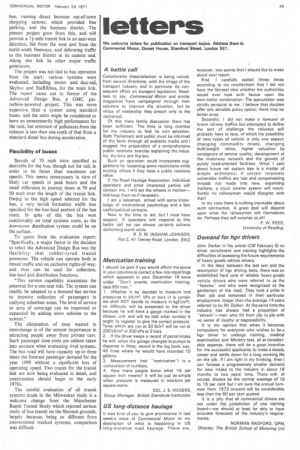letters
Page 47

If you've noticed an error in this article please click here to report it so we can fix it.
We welcome letters for publication on transport topics. Address them to Commercial Motor, Dorset House, Stamford Street, London 5E1.
A battle call
Considerable dissatisfaction is being voiced, from several directions, with the image of the transport industry and in particular its consequent effect on transport legislation. Needless to say, Commercial Motor and similar magazines have campaigned' through their columns to improve the situation, but by virtue of readership they preach only to the converted.
Of this mere family discussion there has been sufficient. The time is long overdue for the industry to find its own salvation. Both Parliament and public must be informed of the facts through all available media and I suggest the preparation of a comprehensive public relations exercise explaining the industry, the lorry and the law.
Such an operation could incorporate suggestions for loosening some restrictions while inviting others if they have a public relations value.
If the Road Haulage Association, individual operators and other interested parties will contact me, I will set the wheels in motion— and keep them so if necessary.
I am a salesman, armed with some knowledge of motivational psychology and a few useful political contacts.
Now is the time to act, but I must have support. If operators will respond to this battle call we can almost certainly achieve something worth while.
R. D. M. INGHAM-JOHNSON, Flat 2, 41 Tierney Road, London, SW2.
Metrication training
I should be glad if you would afford me space in your columns to correct a few mis-reportings which appeared in your December 18 issue under -Don't overdo metrication training, says BSI man."
1. Whether it be decided to measure tyre pressures in kN/m2, kPa or bars (it is certain we shall NOT decide to measure in kgf/cm2), no difficulty will be presented to the driver because he will have a gauge marked in the chosen unit and will be told what number it ought to register to give the correct pressure. Tyres which are run at 30 lb/in' will be run at 200 kN/m2 or 200 kPa or 2 bars.
2. If the driver keeps a record of petrol intake he will, when the garage changes its pumps to dispense in litres, record in the log book, say, 45 litres where he would have recorded 10 gallons.
3, Measurement (not "metrication") is a comparison of numbers.
4. How many people know what 1Ib per square inch means? It will be just as simple when pressure is measured in newtons per square metre.
COL. J. S. VICKERS, Group Manager, British Standards Institution.
US long-distance haulage
It was kind of you to give prominence in last week's issue of Commercial Motor to my description of what is happening in US long-distance road haulage. There are, however, two points that I should like to make about your report.
First. I carefully stated )three times according to my recollection) that I did not have the faintest idea whether the authorities would ever look with favour upon the twin-trailer combination. The speculation was strictly personal to me. I believe that doubles offer one sensible policy option; there may be better ones.
Secondly, I did not make a forecast of future railway traffics but attempted to define the sort of challenge the railways will probably have to face, of which the possibility of new types of vehicle is only one aspect: changing commodity mixes, changing bulk/weight ratios, higher valuation by consignors of service quality, development of the motorway network and the growth of purely road-oriented facilities. What I said about future rail system size is a matter of simple arithmetic; if certain relatively vulnerable traffics are lost and compensating inroads not made into new, expanding markets, a much smaller system will result. Surely no railwayman would disagree with that!
In my view there is nothing inevitable about such contraction. A great deal will depend upon what the railwaymen will themselves do. Perhaps they will surprise us all!
P. W. REED, University of Reading.
Demand for hgv drivers
John Darker in his article (CM February 5) on driver recruitment and training highlights the difficulties of assessing the future requirements of heavy •goods vehicle drivers.
In the days between the last war and the resumption of hgv driving tests, there was an established hard core of reliable heavy goods vehicle drivers who were referred to as the ''heavies" and who were recognized as the gentlemen of the road, They took a pride in their jOla and remained in their particular employment longer than the average 14 years referred to by Mr Darker. At the same time the industry has always had a proportion of "skivers"—rnen who flit from job to job with no sense of loyalty or responsibility,
It is my opinion that when it becomes compulsory for everyone who wishes to be a hgv driver to undergo training, medical examination and Ministry test, all at considerable expense, there will be a great incentive for the successful applicants to make a steady career and settle down for a long working life on the job. If I am right in my thinking, then I can foresee a progressively smaller demand for new intake to the industry in about 18 months to two years' time. There will, of course, always be the normal wastage of 10 to 15 per cent but I am sure the annual turnover from 1973 onward will be considerably less than the 60 per cent quoted.
It is a pity that all commercial drivers are not under the jurisdiction of one training board—we should at least be able to have accurate forecasts of the industry's requirements.
NORMAN RADFORD, QPM, Director, The British School of Motoring Ltd.




























































































